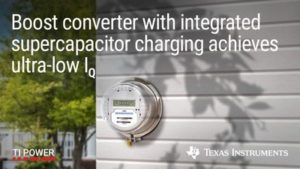Texas Instruments (TI) introduced a new bidirectional buck/boost converter with an ultra-low quiescent current (IQ) of 60 nA, which is one-third the IQ of competing boost converters. The TPS61094 buck/boost converter integrates a buck mode for supercapacitor charging while providing ultra-low IQ, enabling engineers to extend battery life by as much as 20 percent when compared to commonly used hybrid-layer capacitors (HLCs).
 Supercapacitor charging and discharging helps support peak loads and backup power, which are important for continuous operation in battery-powered industrial applications, such as smart meters, smoke detectors, video doorbells, and medical applications.
Supercapacitor charging and discharging helps support peak loads and backup power, which are important for continuous operation in battery-powered industrial applications, such as smart meters, smoke detectors, video doorbells, and medical applications.
Engineers designing battery-operated systems frequently face a common design challenge: a need to achieve high efficiency at no or light-load conditions in the low milliampere or microampere range. This requires power supplies to regulate their output while maintaining ultra-low supply current in the nanoampere range.
The TPS61094 combines two key benefits that previously were trade-offs, the design simplicity of using an integrated buck/boost converter and the extended battery life enabled by high output current and low IQ. (To learn more, read the this technical article.)
Support peak loads and backup power
Today’s lithium thionyl chloride (Li/SOCl₂) battery-based designs often manage peak load with HLCs that are expensive, and not optimal for controlling charge current. The TPS61094’s combined low IQ of 60 nA and supercapacitor charging and discharging enable engineers to replace HLCs with supercapacitors for peak load support and to extend battery life in applications that must run on a single battery for 10 years or more.
Similarly, the TPS61094 can provide back-up power in applications that require safe power-down or last-gasp communication during a power outage.
Deliver twice the output current with the industry’s lowest IQ
In addition to extending battery life, the industry’s lowest-IQ buck/boost converter has a 2-A inductor current limit in boost operation. Therefore, the TPS61094 doubles the output current of competitive boost converters.
The additional output current enables the TPS61094 to support radio standards, such as narrowband Internet-of-things (NB-IoT), LTE-M, Wi-SUN, MIOTY, Bluetooth and wireless M-Bus. This is over a wider input voltage range. As an example, the TPS61094 can support more than 250 mA of output current down to an input voltage of 0.7 V.
Reduce component count
Typical industrial applications such as smart meters require several power components for backup power features or peak load support. Integrating a buck charger and a boost converter into a single IC removes the need for a discrete buck charger, inductor, and two external capacitors — which can reduce component count by 50 percent and free up board space.
Additionally, the integration of the buck charger and boost converter on the TPS61094 allows design engineers to easily control the handshake between all functions, delivering a more seamless transition between operating modes.
Filed Under: Components, News, Power Management


Questions related to this article?
👉Ask and discuss on Electro-Tech-Online.com and EDAboard.com forums.
Tell Us What You Think!!
You must be logged in to post a comment.